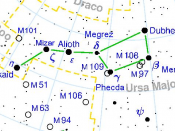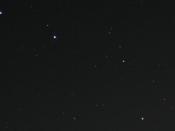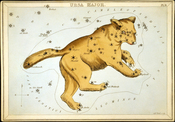Ursa Major is the best known of the constellation and it appears in every reference known. Ursa Major, the Great Bear, is visible in the Northern Hemisphere all year long.
Calisto was changed to a bear because of Zeus's jealousy and transferred her to the sky. This is improbable, as the constellation was already well established before this time.
The drawings all show a bear with a long tail, again not likely correct since bears have no tails. The most likely explanation for the bears and one which I find intriguing is the fact that Native Americans called the constellations the bear, but instead of the tail they depict the bear being chased around the pole by seven braves.
Ursa Minor is a cub of the mother bear, all of this I find fascinating as it is the same story in Asia, could it be that the stories are similar because of common ancestry or contact between the two races?
The Great Bear is extremely easy to identify, look high in the Northeast during May and June in the early evening to locate the seven stars that make up its familiar pattern.
Alioth, Dubhe and Alkaid are all slightly above second magnitude, all shining with a similar brightness. Although they appear the same in magnitude, Alkaid is just over three times the distance of Alioth (210 light-years against 68 light-years) hence is far more luminous - it registers an absolute magnitude is -2.1. The faintest star in the constellation is Megrez (visual magnitude 3.3) although herein lies a mystery; the ancient astronomers of over a thousand years ago perceived Megrez to be the brightest star of the Great Bear. It could well be that Megrez has faded with time.
The constellation Ursa Major contains the group of stars commonly...



Constellations: Ursa Major
Interesting to read and well-written. Good job.
0 out of 0 people found this comment useful.